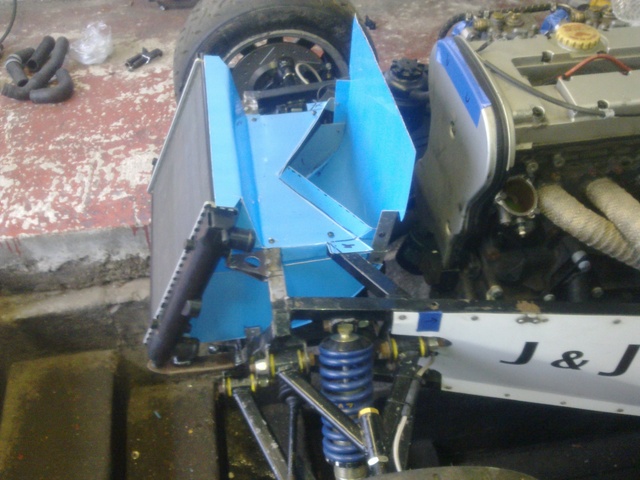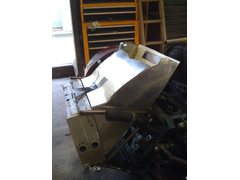Nosey
|
| posted on 30/1/12 at 08:27 AM |

|
|
Radiator Airbox
 
Radiator Airbox
Hey all, just working on this airbox, what do you think? (go easy, this took me an awful lot longer than I was expecting!)
|
|
|
|
|
adithorp
|
| posted on 30/1/12 at 08:35 AM |

|
|
Like it. Why the top piece; Wouldn't it still vent out the nose/bonnet without that?
"A witty saying proves nothing" Voltaire
http://jpsc.org.uk/forum/
|
|
|
Nosey
|
| posted on 30/1/12 at 08:37 AM |

|
|
Still a bit of a work in progress really but I was trying to help the air the most of the way out, try to avoid any shortcuts it might try to take!
|
|
|
tomgregory2000
|
| posted on 30/1/12 at 09:16 AM |

|
|
looks good BUT i would concentrate (sp) on getting the air through the front of the rad, at the moment it will take the path of least resistance and
go round the outside of the rad rather than through
|
|
|
loggyboy
|
| posted on 30/1/12 at 10:00 AM |

|
|
Looks a bit restrictive to me. Surely the opening needs to have the same equivelent area as the Rad, that opening looks to be about the 1/4 of the
rad, so even acounting for the rads natural restrictive air flow, a small opening may cut down its efficency.
[Edited on 30/1/12 by loggyboy]
|
|
|
scutter
|
| posted on 30/1/12 at 10:00 AM |

|
|
Nice work, but your exit will choke. Unless there is something that's going to go above the duct work, I'd suggest going flat from the
top of the rad to the outlet.
I've since enlarged the outlet on my ducting.
 
Rad duct 01
ATB Dan.
[Edited on 30/1/12 by scutter]
The less I worked, the more i liked it.
|
|
|
adithorp
|
| posted on 30/1/12 at 10:05 AM |

|
|
Sealing around the rad'/nose to stop air bypassing the rad' is important as said.
For the exit-box I'd have continued the sides up to meet the top of the nose and not had the top bit(with theV).
"A witty saying proves nothing" Voltaire
http://jpsc.org.uk/forum/
|
|
|
loggyboy
|
| posted on 30/1/12 at 10:09 AM |

|
|
Maybe something more like this (with the front edge ducting shaped to match the nosecose curves.)
 
NoseConeRadDuct
|
|
|
dlatch
|
| posted on 30/1/12 at 10:27 AM |

|
|
is it ok to have the back of the rad shrouded so the only exit for the air is through the fan?
or would you need to leave space at the side as well?
this is on my to do list atm as i am fitting a new polo rad and replacing steel hoses for alloy ones atm
|
|
|
jabbahutt
|
| posted on 30/1/12 at 12:24 PM |

|
|
forgive my complete ignorance but would anyone one mind explaining the advantage of venting the air using this sort of method after it's passed
through the rad rather than just leaving it?
Any explaination to advantages would be appreciated.
Thanks and sorry for the minor hijack
|
|
|
DIY Si
|
| posted on 30/1/12 at 12:25 PM |

|
|
It's more important to put an inlet vent on the rad than an exhuast. It's the cold air in that matters more than getting the hot air out.
However, fitting both will give the best results.
“Let your plans be dark and as impenetratable as night, and when you move, fall like a thunderbolt.”
Sun Tzu, The Art of War
My new blog: http://spritecave.blogspot.co.uk/
|
|
|
scutter
|
| posted on 30/1/12 at 12:36 PM |

|
|
I'd leave as much space as possible on the outlet, just using the fan to assist the airflow through it.
True ensuring all the availible air goes through the rad is important, getting the output air venting through the nosecone is an attempt to lower
under bonnet temps.
ATB Dan.
The less I worked, the more i liked it.
|
|
|
rachaeljf
|
| posted on 30/1/12 at 12:58 PM |

|
|
IMHO Loggyboy's "drinking straw" frame is the way to go. As others have said, you definitely need a cowl in front of the rad. It
doesn't need much, just 2 or 3 inches deep is enough to give you the required stagnation pressure in front of the rad. Loggy's
"spout" should give you a tiny bit of downforce, if that's what you're after.
Cheers R
|
|
|
loggyboy
|
| posted on 30/1/12 at 12:58 PM |

|
|
quote:
Originally posted by jabbahutt
forgive my complete ignorance but would anyone one mind explaining the advantage of venting the air using this sort of method after it's passed
through the rad rather than just leaving it?
Any explaination to advantages would be appreciated.
Thanks and sorry for the minor hijack
A couple of minor advatages, mainly it keeps under bonnet temps lower as the hot air is not being pumped in to the bay, 2ndly (and very neglibly) you
get better aero performace, instead of air just buffeting into the engine bay and either ending along side or under the engine, a proper designed duct
will infact give downforce as its acting like a front wing.
|
|
|
Nosey
|
| posted on 30/1/12 at 01:08 PM |

|
|
Cheers for all the advice lads, the cowling on the front is definitely on the list and I will open up the top part, probably using Loggy's
drawing!
|
|
|
jabbahutt
|
| posted on 30/1/12 at 01:19 PM |

|
|
thanks for taking the time to explain things to me
|
|
|
hicost
|
| posted on 30/1/12 at 03:38 PM |

|
|
Rad
I have played with radioators and shrouds for years, I use my car upto 10,000 feet at least once a year and get stuck in high ambient conditions as
well as track load.
After everything I have tried, the best result was a radiator designed for the job and a fan that can keep the engine cool in high heat traffic.
The fan is not a large diameter job, but is deeper and shifts nearly twice as much air as a standard one. I have a caterham size radiator that is twin
core and the same size as paces three core, and it runs 15 degres cooler as a result.
The fan is a standard off the shelf fan but took a bit of finding.
James
"I cant do that without accidentally grabbing hold of the work of the divine potter"
 
|
|
|
ceebmoj
|
| posted on 30/1/12 at 03:55 PM |

|
|
quote:
Originally posted by DIY Si
It's more important to put an inlet vent on the rad than an exhuast. It's the cold air in that matters more than getting the hot air out.
However, fitting both will give the best results.
If the air can't get out, surly it does not mater how good the inlet vent is?
has any one got pictures of a car with a rad vent and a cold air feed to the engine?
|
|
|
loggyboy
|
| posted on 30/1/12 at 04:23 PM |

|
|
quote:
Originally posted by ceebmoj
quote:
Originally posted by DIY Si
It's more important to put an inlet vent on the rad than an exhuast. It's the cold air in that matters more than getting the hot air out.
However, fitting both will give the best results.
If the air can't get out, surly it does not mater how good the inlet vent is?
has any one got pictures of a car with a rad vent and a cold air feed to the engine?
I think what he was trying to say is its more important to guide air in to the rad (rather than it buffeting around it) than it is to have it
ducted out. (as the OP is only showing ducting out at this time).
|
|
|
se7ensport
|
| posted on 31/1/12 at 06:49 PM |

|
|
quote:
Originally posted by hicost
I have played with radioators and shrouds for years, I use my car upto 10,000 feet at least once a year and get stuck in high ambient conditions as
well as track load.
After everything I have tried, the best result was a radiator designed for the job and a fan that can keep the engine cool in high heat traffic.
The fan is not a large diameter job, but is deeper and shifts nearly twice as much air as a standard one. I have a caterham size radiator that is twin
core and the same size as paces three core, and it runs 15 degres cooler as a result.
The fan is a standard off the shelf fan but took a bit of finding.
James
James, please can you share further details of the fan and radiator i.e. make of fan and if rad is custom or available from a supplier.
thanks
Alex
|
|
|













